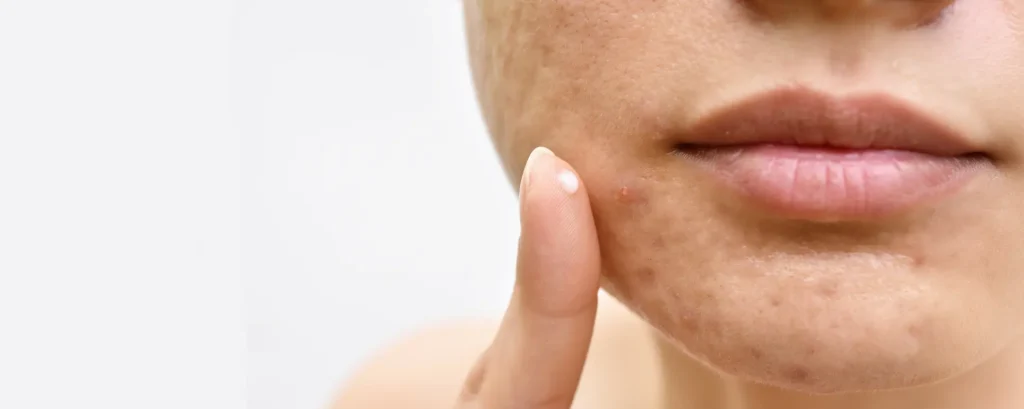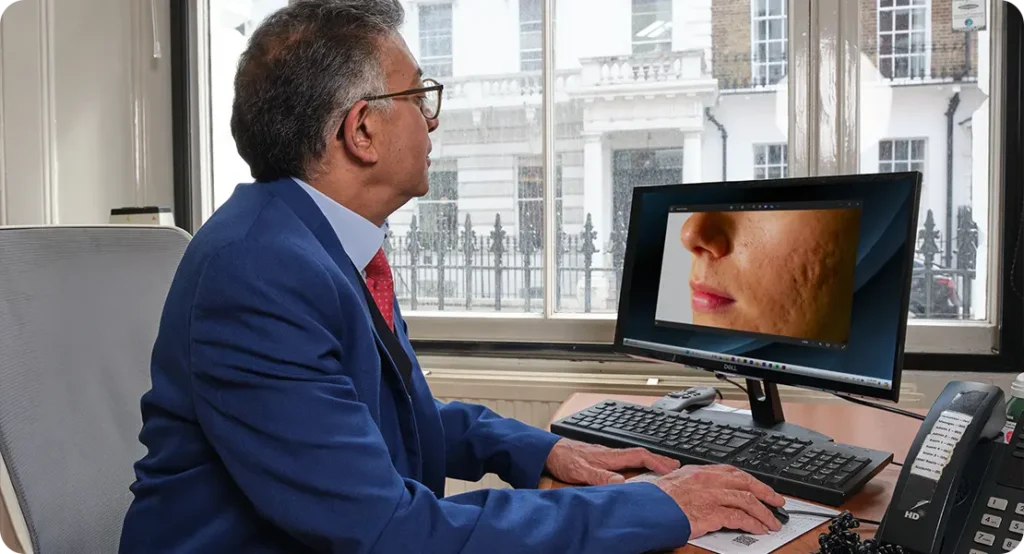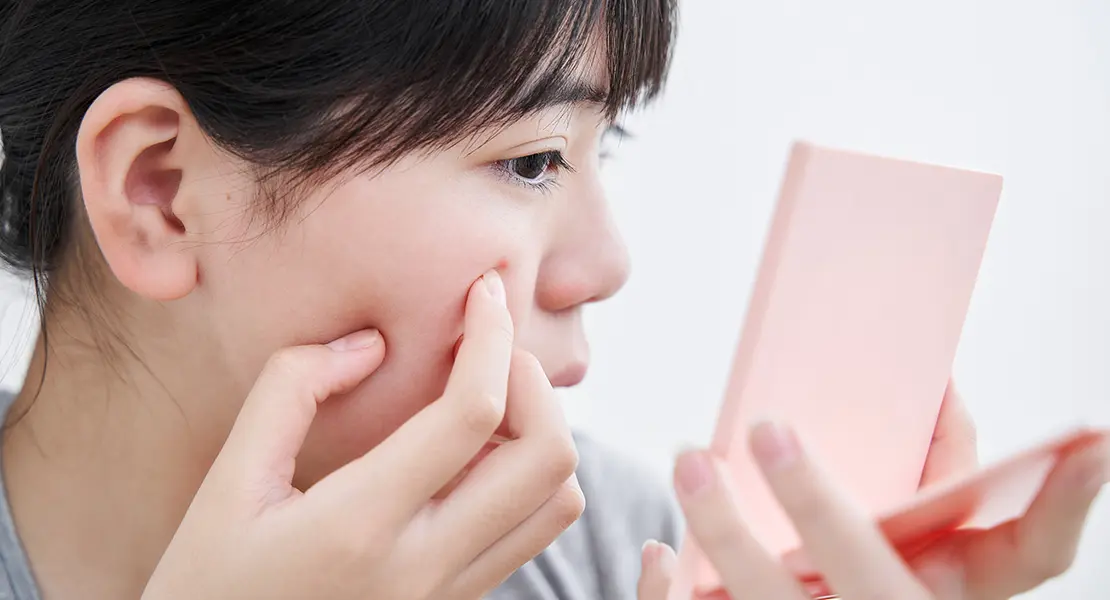There’s nothing more frustrating than thinking you’ve finally cleared a pimple, only for it to reappear in the exact same place not long after. You celebrate when the redness fades, only to feel that familiar tenderness under the skin a few days later. It’s almost like your skin is stuck on repeat, targeting the same area over and over again no matter what you do.
This cycle isn’t just irritating it can feel discouraging, too. You might wonder if you’re doing something wrong with your skincare routine, if your products aren’t working, or if there’s a deeper issue that keeps bringing the blemish back. The truth is, recurring breakouts in the same spot are surprisingly common, and they usually aren’t random. Instead, they’re often a sign that something specific is happening with your skin, your habits, or even your overall health.
There are many reasons a breakout can return to the same location. Sometimes, it’s as simple as a clogged pore that never fully healed, leaving behind a weak spot where bacteria and oil can easily build up again. Other times, it’s caused by repeated irritation like always resting your chin in your hand, wearing tight headbands, or using pillowcases that aren’t washed often enough. Hormones, stress, and diet can also influence these patterns, as can certain skin conditions that make particular areas more vulnerable.
Another factor to keep in mind is that skin has what dermatologists sometimes call a “memory.” Once a pore has been inflamed or infected, the surrounding tissue may remain more fragile, making it prone to repeated flare-ups. That’s why the same place can seem like a permanent trouble zone, even if the rest of your skin looks completely clear.
Understanding why breakouts keep coming back in the same area is the first step to breaking the cycle. By looking at the patterns in your skin’s behaviour and addressing the underlying triggers whether external or internal you can finally give your skin the chance to heal properly.
In this guide, we’ll explore the most common reasons you might be breaking out in the same spot, the habits or health factors that could be contributing, and how to stop these repeat blemishes once and for all. We’ll also look at how professional dermatology care can help when at-home fixes just aren’t enough.
Common Reasons for Recurring Breakouts

If you find pimples showing up in the same place again and again, you’re definitely not alone. Breakouts that keep returning usually point to an underlying factor that hasn’t been fully addressed. Here are the most common causes in more detail:
1. Clogged Pores
Clogged pores are the most frequent reason behind stubborn, recurring breakouts. Pores are tiny openings that release oil and sweat, but when they become blocked by dead skin cells, sebum, and debris, they act like a trap for bacteria. The pore becomes inflamed, leading to a pimple.
Even when the breakout heals on the surface, residue can remain inside the pore. This leftover blockage creates a cycle where the same pore continues to flare up. If you’ve ever felt like you have a “permanent pimple” in one spot, it’s usually because that pore never fully cleared. Without interventions like regular exfoliation, non-comedogenic skincare products, or professional treatments, this problem may persist for months.
2. Hormonal Fluctuations
Hormones are a powerful driver of acne, especially recurring acne. When hormones like androgens surge, they stimulate sebaceous glands to produce more oil. This excess oil clogs pores and creates the perfect conditions for breakouts.
Many people notice that hormonal acne tends to appear in very specific zones such as the jawline, chin, or around the mouth and often returns in these same areas repeatedly. Women, in particular, may find that breakouts occur in sync with their menstrual cycle, while stress-related hormonal changes can trigger flare-ups in already vulnerable areas. Because these fluctuations are cyclical, the pimples they cause often return to the same location over and over again.
3. Scar Tissue or Previous Damage
Areas of skin that have previously been inflamed or scarred don’t always heal as smoothly as healthy skin. The pore structure may be altered, the tissue may be weaker, and oil may become trapped more easily. This makes scarred or damaged spots especially prone to repeated breakouts.
Think of it like a weak point in your skin’s armour: once that spot has been compromised, it’s more likely to be targeted again. Without treatments aimed at resurfacing or strengthening the skin such as retinoids, chemical peels, or dermatologist-led procedures the cycle may continue.
4. Bacterial Overgrowth
Your skin has a natural microbiome made up of bacteria, fungi, and other microorganisms. Most of them are harmless or even helpful. But when acne-causing bacteria like Cutibacterium acnes multiply excessively, they can inflame the same pore again and again.
This bacterial overgrowth may be encouraged by factors like oily skin, sweat buildup, or using heavy creams and makeup that trap bacteria inside pores. Once bacteria establish themselves in a pore, it becomes a hotspot for recurring inflammation until balance is restored through proper skincare or medical treatment.
5. Lifestyle and External Factors
Everyday habits often trigger repeat breakouts in the same spot without us realising it. For example:
- Resting your chin on your hand while working or studying.
- Pressing your phone against your cheek during calls.
- Wearing masks, helmets, or tight straps that create friction on the skin.
- Sleeping on pillowcases that aren’t changed often enough.
These repeated sources of irritation weaken the skin barrier and provide opportunities for bacteria to thrive. If the same pressure or friction happens in the same place day after day, the breakouts will keep appearing in that very spot.
6. Stress and Emotional Triggers
Stress doesn’t just affect your mind it shows up on your skin too. High stress levels stimulate the production of cortisol, a hormone that increases oil production and inflammation. For people already prone to acne, this can create a cycle where certain areas flare up repeatedly during stressful periods.
You might even notice that breakouts reappear in the exact same spot when you’re under pressure at work, during exams, or when life feels overwhelming. This is because stress hormones interact with existing vulnerabilities in the skin, targeting areas that are already fragile or inflamed.
7. Diet and Food Sensitivities
What you eat can also influence recurring breakouts. Diets high in refined sugar, dairy, or processed foods may contribute to increased oil production and inflammation. For some individuals, certain trigger foods cause breakouts to appear in predictable locations.
For instance, dairy-related breakouts often appear on the chin and jawline, while diets high in sugar may trigger pimples on the forehead or around the mouth. If you notice the same spot flaring up after particular meals or dietary patterns, food may be a hidden factor worth exploring.
8. Skincare or Haircare Products
Sometimes, the products meant to help your skin can actually make things worse. Heavy moisturisers, thick sunscreens, or hair products that spread onto your face may contain comedogenic (pore-clogging) ingredients. If these products consistently come into contact with a certain area like your forehead, hairline, or cheeks that area may keep breaking out.
This is often called “acne cosmetica.” Switching to lighter, non-comedogenic products can help stop the cycle of repeat blemishes in those areas.
9. Genetics and Skin Type
Finally, your skin type and genetics play a role. Some people naturally have oilier skin or slower cell turnover, both of which increase the risk of clogged pores. If you’ve inherited a tendency toward acne, you may notice certain areas of your face are always problem zones. Genetics won’t change, but understanding your predispositions can guide you toward the right treatment plan.
How Dermatologists Approach Recurring Breakouts

When pimples keep returning to the same spot, it’s often a sign that something beneath the surface hasn’t been fully addressed. While home remedies and over-the-counter products can help in some cases, recurring breakouts often need expert evaluation. A dermatologist in London can provide a personalised approach, focusing not only on clearing current acne but also on preventing it from coming back.
Here’s how dermatologists typically manage persistent and recurring acne:
1. Comprehensive Skin Examination
A dermatologist’s first step is always assessment. They will examine your skin closely, noting the type of lesions (blackheads, whiteheads, cysts, or nodules), the severity of inflammation, and the exact areas where breakouts keep returning.
They may also look for patterns for example, whether acne appears mainly along the jawline (which could suggest hormones), around the hairline (often linked to hair products), or on the cheeks (sometimes connected to phone use or pillowcases). In addition to the skin exam, they’ll take a full medical history, asking about your lifestyle, diet, stress levels, skincare routine, and family history of acne. This holistic view is crucial because recurring breakouts often stem from more than one factor.
2. Diagnostic Tests (If Needed)
For stubborn cases, dermatologists may run further investigations. Blood tests can check for hormonal imbalances, such as high androgen levels, that may be driving persistent jawline acne. In women, conditions like polycystic ovary syndrome (PCOS) can be linked to recurring spots. Patch testing may be recommended if an allergic reaction or skin sensitivity is suspected, particularly if breakouts occur in areas that come into contact with skincare or haircare products.
These extra steps help pinpoint hidden causes that topical creams alone won’t resolve.
3. Prescription-Strength Topical Treatments
Once the cause is clearer, dermatologists often start with prescription topical medications. These may include:
- Topical retinoids (such as adapalene or tretinoin) to speed up cell turnover and prevent pores from clogging.
- Benzoyl peroxide creams to kill acne-causing bacteria and reduce inflammation.
- Topical antibiotics to target bacterial overgrowth in recurring areas.
- Azelaic acid for patients with sensitive skin or post-inflammatory marks.
These treatments are much stronger than most shop-bought options and are tailored to suit your exact skin type and acne pattern.
4. Oral Medications for Deeper Causes
For more persistent or widespread breakouts, dermatologists may turn to oral medications. These can include:
- Antibiotics to reduce bacterial load and inflammation.
- Hormonal therapies, such as oral contraceptives or spironolactone, for patients with hormonally driven breakouts.
- Isotretinoin (Roaccutane) in severe, resistant cases, which works by shrinking oil glands and preventing clogged pores.
Unlike over-the-counter treatments, these medications target the deeper causes of recurring acne, not just the surface symptoms.
5. Personalised Skincare and Lifestyle Guidance
A huge part of managing recurring breakouts is education. Dermatologists will review your current skincare products and routine, pointing out anything that might be making the issue worse, such as harsh scrubs, overly drying cleansers, or comedogenic (pore-clogging) ingredients. They may recommend switching to gentle, non-comedogenic formulations that support the skin barrier rather than stripping it.
Lifestyle is also addressed. A dermatologist may highlight the role of stress management, diet, hydration, and sleep in supporting skin health. Even small adjustments such as cleaning pillowcases more often, limiting dairy intake, or reducing face-touching can make a surprising difference in breaking the cycle of repeat pimples.
6. Advanced Dermatology Procedures
For breakouts that resist both topical and oral medications, dermatologists may recommend in-clinic treatments. These include:
- Chemical peels to deeply exfoliate and clear out blocked pores.
- Laser and light therapies (such as blue light therapy) to kill acne-causing bacteria and reduce oil production.
- Microdermabrasion or microneedling to smooth damaged skin and help prevent future blockages.
- Comedone extraction performed under sterile conditions to safely clear clogged pores that keep causing breakouts.
These procedures provide faster relief and long-term improvements, especially for patients who have been stuck in a cycle of recurring breakouts for years.
7. Long-Term Monitoring and Aftercare
Perhaps the most valuable aspect of seeing a dermatologist is ongoing support. Acne is rarely a one-time issue; it often requires maintenance. Dermatologists typically create a long-term treatment plan that evolves with your skin’s needs. They’ll monitor your progress, adjust treatments if your skin becomes dry or irritated, and help prevent scarring or post-acne pigmentation.
By working closely with a dermatologist, you get a tailored plan that not only clears existing breakouts but also strengthens your skin against future flare-ups.
Preventing Recurring Spots

While professional care is essential for stubborn or recurring acne, there are several preventive steps you can take at home to reduce the likelihood of breakouts reappearing in the same areas. Small lifestyle adjustments and mindful habits can go a long way in supporting clearer, healthier skin.
1. Stick to a Gentle Cleansing Routine
Wash your face twice daily using a mild cleanser that suits your skin type. Over-washing or using harsh scrubs can strip away natural oils, leading your skin to produce even more oil and worsening breakouts. A consistent routine helps remove dirt, sweat, and excess sebum without disrupting the skin barrier.
2. Avoid Picking or Squeezing Spots
It can be tempting to touch or squeeze blemishes, but doing so often drives bacteria and inflammation deeper into the skin. This not only delays healing but also increases the risk of scarring and repeat breakouts in the same spot. Instead, let treatments or prescribed medication work naturally.
3. Keep Everyday Items Clean
Items that come into frequent contact with your skin can carry bacteria and oils that trigger spots. Changing pillowcases regularly, wiping down phone screens, and cleaning makeup brushes are simple but powerful ways to prevent reinfection and irritation.
4. Monitor Triggers Closely
Many people find that certain factors such as hormonal cycles, high stress levels, poor sleep, or a diet high in sugary and processed foods can set off breakouts. Keeping a skincare journal can help you identify patterns and make lifestyle changes to minimise flare-ups.
5. Choose Non-Comedogenic Products
When it comes to skincare and makeup, opt for non-comedogenic (non-pore-clogging) formulas. Heavy or greasy products can trap oil and bacteria, creating conditions where acne can return. Lightweight, breathable products are better for preventing repeat congestion.
6. Protect Your Skin from Excessive Irritation
Friction and pressure from helmets, tight masks, or headgear can lead to repeated breakouts in the same area, often referred to as “acne mechanica.” Reducing friction and ensuring that these items are kept clean can help reduce recurring spots.
7. Focus on Overall Wellness
Supporting your skin from the inside is just as important as topical care. Staying hydrated, eating a balanced diet rich in fruits, vegetables, and omega-3 fatty acids, and managing stress through relaxation techniques can all reduce the frequency of breakouts.
By combining these preventive steps with guidance from a dermatologist, you can significantly reduce the risk of spots returning to the same areas of your face or body.
Final Thought: Breaking the Cycle of Recurring Acne
Recurring breakouts in the same spot are frustrating, but understanding the underlying causes can make a huge difference. With proper skincare, lifestyle adjustments, and professional guidance, you can break the cycle. For personalised evaluation and targeted treatment, you can consult a skilled dermatologist in London, who can help you address both the symptoms and root causes of recurring acne.
References:
- Vasam, M. (2023) Acne vulgaris: A review of the pathophysiology, treatment … PMC. Available at: https://pmc.ncbi.nlm.nih.gov/articles/PMC10709101/
- Nandy, P. (2024) Exploring the Multifaceted Impact of Acne on Quality of Life. PMC. Available at: https://pmc.ncbi.nlm.nih.gov/articles/PMC10879740/
- Yang, J. (2020) A Review of Advancement on Influencing Factors of Acne. PMC. Available at: https://pmc.ncbi.nlm.nih.gov/articles/PMC7527424/
- NIAMS (2023) Acne Types, Causes, & Risk Factors. NIAMS (National Institute of Arthritis and Musculoskeletal and Skin Diseases). Available at: https://www.niams.nih.gov/health-topics/acne
ang, J., et al. (2020) Diet and Acne: A Review of the Evidence. International Journal of Dermatology. DOI: 10.1111/ijd. https://en.wikipedia.org/wiki/Acne?utm_source=chatgpt.com
